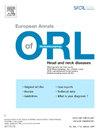Closure without epiglottoplasty or tracheotomy after reconstructive frontal anterior laryngectomy
IF 2.4
4区 医学
Q2 OTORHINOLARYNGOLOGY
European Annals of Otorhinolaryngology-Head and Neck Diseases
Pub Date : 2025-01-01
DOI:10.1016/j.anorl.2024.06.003
引用次数: 0
Abstract
Reconstructive frontal anterior laryngectomy (RFAL) is a partial laryngeal surgery technique for resecting early-stage (T1–T2) glottic squamous cell carcinoma. Indications comprise a lesion of the anterior commissure of the larynx that cannot be adequately exposed by endoscopy, and cases in which radiotherapy is refused or contraindicated. The initial RFAL technique included epiglottoplasty. Here we propose a technique without epiglottoplasty, with the advantage of avoiding need for tracheotomy in most cases. After the first stage of surgical excision, reconstruction consists in placing a vertical brace transepiglottically and below the cricoid. The epiglottis is thus left at its original height and secured in place to prevent flapping in the pharyngolaryngeal lumen. Transverse bracing is then performed through the thyroid wings: one of the key points of this surgery is to control tension to avoid risk of stenosis. The subhyoid muscles are sutured together to achieve satisfactory sealing. This technique offers satisfying functional results and oncological control. The most frequent complications are (1) secondary tracheotomy, which can be avoided by selecting patients who require a primary tracheotomy and optimizing the seal, and (2) stenosis, which can be limited by not bringing the cartilaginous structures too close together during bracing.
重建额前喉切除术后无需会厌成形术或气管切开术即可闭合。
重建额前喉切除术(RFAL)是一种喉部分手术技术,用于切除早期(T1-T2)声门鳞状细胞癌。适应症包括无法通过内窥镜充分暴露的喉前会厌病变,以及拒绝或禁忌放疗的病例。最初的 RFAL 技术包括会厌成形术。在这里,我们提出了一种无需会厌成形术的技术,其优点是在大多数病例中无需进行气管切开术。在第一阶段手术切除后,重建工作包括在会厌和环状舌骨下方放置一个垂直支架。这样会厌就保持在原来的高度,并固定在适当的位置,以防止在咽喉腔内拍打。然后通过甲状腺翼进行横向支撑:该手术的要点之一是控制张力以避免狭窄风险。将胸骨下肌肉缝合在一起,以达到满意的密封效果。这种技术可提供令人满意的功能效果和肿瘤控制。最常见的并发症是:(1) 二次气管切开,这可以通过选择需要一次气管切开的患者和优化密封来避免;(2) 狭窄,这可以通过在支撑时不将软骨结构靠得太近来限制。
本文章由计算机程序翻译,如有差异,请以英文原文为准。
求助全文
约1分钟内获得全文
求助全文
来源期刊

European Annals of Otorhinolaryngology-Head and Neck Diseases
OTORHINOLARYNGOLOGY-
CiteScore
3.70
自引率
28.00%
发文量
97
审稿时长
12 days
期刊介绍:
European Annals of Oto-rhino-laryngology, Head and Neck diseases heir of one of the oldest otorhinolaryngology journals in Europe is the official organ of the French Society of Otorhinolaryngology (SFORL) and the the International Francophone Society of Otorhinolaryngology (SIFORL). Today six annual issues provide original peer reviewed clinical and research articles, epidemiological studies, new methodological clinical approaches and review articles giving most up-to-date insights in all areas of otology, laryngology rhinology, head and neck surgery. The European Annals also publish the SFORL guidelines and recommendations.The journal is a unique two-armed publication: the European Annals (ANORL) is an English language well referenced online journal (e-only) whereas the Annales Françaises d’ORL (AFORL), mail-order paper and online edition in French language are aimed at the French-speaking community. French language teams must submit their articles in French to the AFORL site.
Federating journal in its field, the European Annals has an Editorial board of experts with international reputation that allow to make an important contribution to communication on new research data and clinical practice by publishing high-quality articles.
 求助内容:
求助内容: 应助结果提醒方式:
应助结果提醒方式:


